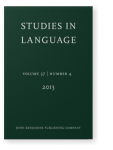Vol. 37:4 (2013) ► pp.810–845
Thai motion verbs paj and maa
Where tense and aspect meet
Temporality in Thai and other Southeast Asian languages has traditionally been analyzed as based on pre-established European notions of tense and aspect, thus yielding problematic analyses. This paper offers an alternative way of analyzing and explaining temporality in Thai in its own terms. It focuses on the basic motion verbs paj and maa and shows that they can specify states of affairs in different domains, such as space, time, and attributes. Their usage relies on the close association of linguistic and pragmatic contexts. In the domain of time, Thai paj and maa display characteristics of both tense and aspect, showing that tense/aspect systems are substantially more diverse than has traditionally been assumed. The concept of reference plays an important role even in a tenseless language such as Thai.
Cited by
Cited by 4 other publications
This list is based on CrossRef data as of 16 june 2024. Please note that it may not be complete. Sources presented here have been supplied by the respective publishers. Any errors therein should be reported to them.
